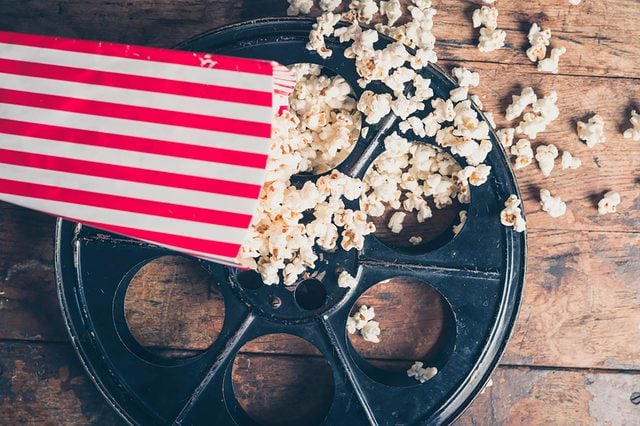Movie Theaters Used to BAN Popcorn (Seriously!)—but Here’s Why We Can Buy It Now
Updated: Apr. 01, 2022
Thank goodness movie theater owners came to their senses.
 I don’t know about you, but eating movie theater popcorn is
I don’t know about you, but eating movie theater popcorn is almost just as exciting as watching the actual movie. Can you imagine watching your favorite flick without a bowl of buttery, salty, crunchy kernels by your side? Of course, there are healthy ways to eat popcorn, but either scenario is just sad.
Concession stands are a staple in movie theaters as much as the new releases they screen, but early on in American cinema history, popcorn wasn’t allowed in any theater.
Popcorn came to America in the early 19th century, when New England whalers brought it back from Chile. Soon it was popping all across the country, mostly because it was cheap and just fun to make. When Charles Cretor invented the first steam-powered popcorn maker in 1885, it became easy to make anywhere. So people did. It was the perfect snack to mass-produce for sporting events, circuses, and fairs. Just not at the movies.
Movie theaters at the time wanted to mirror the elegance of real theaters, Andrew Smith, author of Popped Culture: A Social History of Popcorn, told the Smithsonian. That meant lavish décor and upper class clientele. (Only educated people who knew how to read could enjoy movies because all films were silent ones back then.) Add popcorn into that equation, and you get dirty carpets, overflowing trash bins, and incessant chewing that would distract people from the movie.
And so popcorn was banned, but that didn’t stop moviegoers from getting their hands on it. Street vendors would set up popcorn stands outside theaters, just so customers could smuggle bags of it into a movie. Some theaters caught on and even asked people to check their popcorn with their coats. Talk about cracking down on contraband. (These are the secrets movie theater employees won’t tell you.)
Then, in 1927, the world changed. Films added sound, making a better overall viewer experience and bringing in larger audiences. Not even the Great Depression could stop moviegoers, who saw films as a cheap escape and popcorn as the perfect cheap snack. Bags were just 5 to 10 cents each! (And as far as the annoying munching from the audience, the sound from the movies covered that up.)
Eventually, theater owners realized how profitable popcorn sales could be. In fact, the theaters that sold concessions were the ones that survived the Depression. By 1945, over half of the popcorn consumed in America was eaten at the movies. Not much has changed, considering theaters make an estimated 85 percent of their profits from concessions alone. And no matter how much the prices are marked up, we consumers will continue to buy popcorn—because it really wouldn’t be a trip to the movies without it.